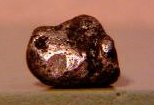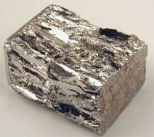 Discovery Information Discovery Information
|
| Who: Known to the ancients. Bismuth was also known to the Incas and used (along with the usual copper and tin) in a special bronze alloy for knives.
|
|
 Name Origin Name Origin
|
| German: wissmuth (white mass). |
| "Bismuth" in different languages. |
|
 Sources Sources
|
| It can be found free in nature and in minerals like bismuthine (Bi2O3) and in bismuth ochre (Bi2O3). Canada, Bolivia, Japan, Mexico and Peru are major producers.
|
| World production is around 3000 tons annually. |
|
 Abundance Abundance
|
| Universe: 0.0007 ppm (by weight) |
| Sun: 0.01 ppm (by weight) |
| Carbonaceous meteorite: 0.07 ppm |
| Earth's Crust: 0.048 ppm |
| Seawater: |
| Atlantic surface: 5.1 x 10-8 ppm
|
| Atlantic deep: ppm |
| Pacific surface: 4 x 10-8 ppm
|
| Pacific deep: 4 x 10-9 ppm
|
|
 Uses Uses
|
| Main use is in pharmaceuticals, low melting point alloys, fuses, sprinklers, glass, ceramics and as a catalyst in rubber production. Strong permanent magnets can be made from the alloy "bismanol" (MnBi). In the early 1990s, research began to evaluate bismuth as a nontoxic replacement for lead in various applications.
|
| Bismuth is sometimes used in the production of shot and shotgun slugs. Its advantage over lead in this respect is that it is non-toxic and therefore legal in the UK for the shooting of wetland birds.
|
| Bismuth has also been used in solders. The fact that bismuth and many of its alloys expand slightly when they solidify make them ideal for this purpose.
|
|
 History History
|
| Bismuth was confused in early times with tin and lead due to its resemblance to those elements. Basilius Valentinus described some of its uses in 1450. Claude Francois Geoffroy
showed in 1753 that this metal is distinct from lead.
|
| Bismuth was also known to the Incas and used (along with the usual copper and tin) in a special bronze alloy for knives.
|
|
 Notes Notes
|
| While bismuth was traditionally regarded as the element with the heaviest stable isotope, it had long been thought to be unstable on theoretical grounds. Not until 2003 was this demonstrated when researchers at
the Institut d'Astrophysique Spatiale in Orsay, France, measured the alpha emission half-life of 209Bi to be 1.9 x 1019 years, meaning that bismuth is very slightly radioactive, with a half-life over a billion times longer than the current estimated age of the universe. Due to its extraordinarily long half-life, for
nearly all applications bismuth can be treated as if it is stable and non-radioactive. However, the radioactivity is of academic
interest because bismuth is one of few elements whose radioactivity was suspected, and indeed theoretically predicted, before
being detected in the laboratory.
|
| Elemental bismuth is one of very few substances of which the liquid phase is denser than its solid phase (water being the
best-known example). Because bismuth expands on freezing, it was long an important component of low-melting typesetting alloys
which needed to expand to fill printing molds.
|
| In the early 1990s, research began to evaluate bismuth as a nontoxic replacement for lead in various applications.
|
|
 Hazards Hazards
|
| Among the heavy metals, bismuth is unusual in that its toxicity is much lower than that of its neighbours in the periodic
table such as lead, thallium and antimony.
|
| Finely divided powder is highly flammable. |





 Discovery Information
Discovery Information
 Name Origin
Name Origin
 Sources
Sources
 Abundance
Abundance
 Uses
Uses
 History
History
 Notes
Notes
 Hazards
Hazards
 Images
Images


